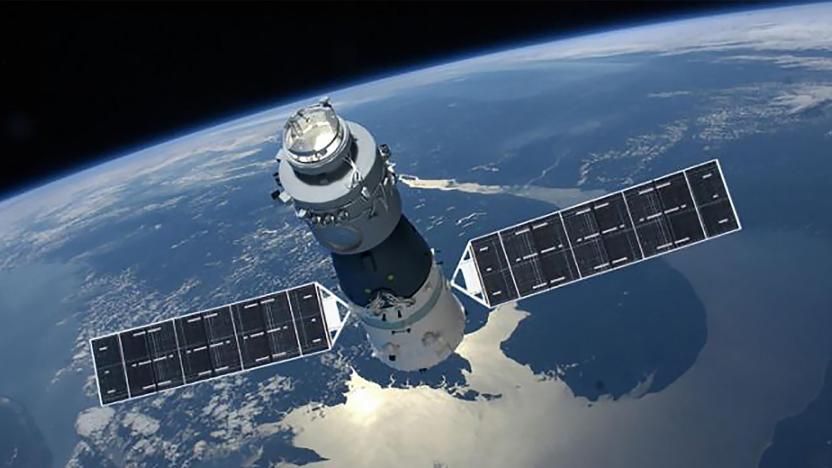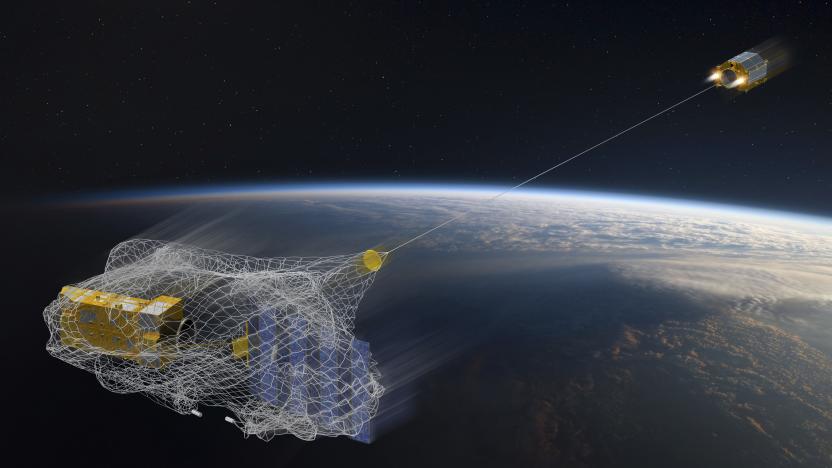tiangong-1
Latest

China's first space station burns up over the South Pacific
China's Tiangong-1 has met its fiery end. The out-of-control space station plummeted through the Earth's atmosphere at roughly 7:15pm ET on Sunday evening, as expected. Most of Tiangong-1 was destroyed during re-entry, however parts crash-landed somewhere over the South Pacific Ocean. Speaking to Reuters, astrophysicist Brad Tuckers estimated that 10 percent, or 700 to 800KG may have made it to the Earth's surface. "Most likely the debris is in the ocean, and even if people stumbled over it, it would just look like rubbish and be spread over a huge area," he said.

After Math: When it all comes crashing
It's turning out to be a great week for falling objects. China's first space station is set to reenter the Earth's atmosphere, IBM's 50-qubit processor record was felled by Google's latest invention, the FBI and Geek Squad's cozy narc relationship has been revealed and the White House has decided it wants to be able to shoot civilian drones out of the skies. Numbers, because how else will you gauge how fast you're falling?

China’s first space station will hit the Earth’s atmosphere soon
There's a space station in a decaying orbit. It's going to fall back to Earth. And we don't know where or when it will hit. No, this isn't the plot of a terrible action movie. The Chinese space station Tiangong-1 is headed for an uncontrolled reentry into Earth's atmosphere. The European Space Agency (ESA) has been monitoring the situation; today, it delivered an update narrowing down the crash window. The space station will fall somewhere between 43 degrees North and South, but because of the angle of the Tiangong-1, it's more likely to fall near the maximum or minimum than on the equator. The reentry time frame is between March 29th and April 9th, but the ESA notes that this is highly variable.

The robots that will sweep Earth's skies
After six years in space, China's first orbital station, the Tiangong-1 (aka the "Heavenly Palace") has finally outlived its operational limits and begun its descent to Earth. It's expected to re-enter the atmosphere in a few months, whereupon a majority of the 9.3-ton station should burn up before reaching the surface. This is how defunct satellites are supposed to be disposed of. Unfortunately, until very recently, that hasn't often been the case.

China sending a probe to the moon next year to look for Moonbase Alpha
State news agency Xinhua is reporting that China is planning to launch a probe to the moon in the second half of 2013. The Chang'e-3, named after the Chinese moon goddess, will deposit a lander and rover on our natural satellite to survey its bumpy surface. It'll launch from the Xichang Satellite Launch Center in Sichuan province and is a sign of the continuing ambition of the nation's space program -- after it deposited a crew on its Tiangong-1 space station two months ago.

Chinese astronauts go hands-on, manually dock with orbiting module
Looks like China continues to add to its space cred after recently joining the rarefied ranks of countries that have successfully docked craft in the final frontier. Fresh off from the recent joining of the Shenzhou 9 capsule with the Tiangong 1 orbiting module, China's three astronauts have now replicated the feat manually, according to the Washington Post . For the uninitiated, the first docking was done via remote control from the ground. The mission has had plenty of firsts for China so far, including the country's first female astronaut. It also serves as a precursor to establishing China's first permanent space station, a 60-ton facility that's about a sixth of the size of the International Space Station but is slightly bigger than NASA's old Skylab. 'Cause sometimes, you just gotta have your own space in space, you know? [Image credit: Associated Press]

China conducts its first crewed spaceship docking, gives east Asia its place in space (updated)
Believe it or not, the only countries to have docked a human-helmed spacecraft in the first 50 years of spaceflight were Russia and the US. That small community just got bigger, as China's Shenzhou-9 has successfully docked with the Tiangong-1 module put in orbit for just such a test. The link-up is being used for experiments in the short term, but it's a key step in a program that will ultimately lead to a full-fledged Chinese space station. On top the wider ambitions, the docking also marks a victory for gender-neutral space travel: Liu Yang, one of three crew members, is the country's first female spacefarer. China's space program has a long road ahead, but it's clear the International Space Station won't be alone for much longer. Update: Yes, China more accurately covers east Asia, not just the southeast. Our apologies!

China planning manned mission to its own space station, didn't want to be on the ISS anyway
State news agency Xinhua is reporting that China is planning to launch a manned spacecraft later this month. A Shenzhou-9 capsule and rocket are already in place, and when it launches it'll manually dock with the nation's space station: Tiangong-1. The nation is moving quickly to capitalize on its successes last year, after learning how to dock two objects in high-speed orbit. Once both are linked up, the three astronauts on-board would move across to perform scientific experiments before returning to Earth in the craft, as you do. [Image Credit: China Daily]

China launches unmanned, auto-docking spacecraft
China isn't wasting any time getting its space station ducks in a row. After launching the first piece of the Tiangong (Heavenly Palace) in late September, the country has already put its first companion craft, Shenzhou-8, into orbit alongside it. The Shenzhou is another unmanned craft, packed with a collection of 17 biological experiments. The real fun though, will begin on day three of its mission, when it attempts an automated docking with the Tiangong. Being able to send up unmanned supply vehicles has its obvious advantages, but this is only a test run -- don't expect self-piloting craft to start ferrying food and replacement parts to the ISS any time soon. After 12 days of conjoined orbiting, the Shenzhou-8 will disengage from the Tiangong and head back to Earth. Hey, maybe our astronauts can save some cash by hiding in the cargo hold of these Chinese robo-craft.

China readies its own space station module for launch
Presumably feeling a little left out after being turned down from the global love-in that is the International Space Station, China's decided to go it alone. The ever-expanding nation will be ready to launch the first module of it's very own space station, the Tiangong (Heavenly Palace), by the end of this month. The initial launch will be unmanned, delivering an 8.5-ton module ready for docking practise and other interactions with three more spacecraft that are planned to join it later this year. Pegged for completion by 2020 and with a complete weight of over 60 tons, the Tiangong will look positively petite compared to the hulking 419-ton ISS, but is also said to be significantly cheaper. Meanwhile, we still await China's take on the Robonaut.

China's Tiangong 1 space station unveiled for tiny Taikonauts
Ok, it's just a scale model, but what you're looking at is the first module from China's budding Tiangong (meaning "Heavenly Place") space station program. It was just revealed to the surprise and delight of Engadget Chinese during a TV special celebrating the Chinese New Year. The 8 ton module is scheduled to launch by 2010 with two more modules (Tiangong 2 and Tiangong 3) to follow by 2015 after which Taikonauts will begin to stay in orbit. For now, the endeavor is meant to prepare for automated docking trials and to establish a presence in space -- a move that will undoubtedly scare the hell out of hawkish members of western governments.







